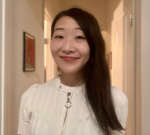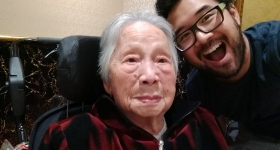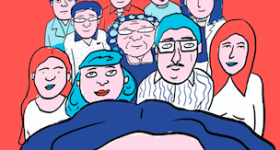In the Korean drama “The Heirs,” South Korean actress Park Shin-Hye plays Cha Eun-Sang, a teenage girl who, while working multiple part-time jobs to help support her single mother, attends an elite private high school as a scholarship student, where she is rumored to be a “parvenu,” someone who has recently gained wealth or a sudden rise in status. The show follows Eun-Sang and her affluent Jeguk High classmates, such as the heiress Rachel Yoo, who emits a villainous prep school haughtiness, or Lee Bo-Na, the jealous but ultimately warm-hearted girlfriend of Eun-Sang’s male best friend, who wears berets and is often shown swinging her long hair.
“The Heirs,” also referred to as “The Inheritors,” aired in South Korea in 2013, but I watched it in 2020. All around me, people were turning to creature comforts. For months, the city had been shut down, and I was lucky enough to find myself safely indoors, marathoning Netflix and living a forced domesticity that I hadn’t expected. Clearly reminiscent of shows like “The OC” and “Gossip Girl,” “The Heirs” promised to be a distracting quarantine binge.
I started watching “The Heirs” partly to listen to Korean being spoken. During quarantine, I began a calming routine of studying Korean, practicing at my kitchen table every week. There were other hints of Korean culture in my daily quarantine life as well. I soaked cabbage overnight to make jars of kimchi. I revisited K-pop playlists. I made soju cocktails with apple juice. These activities helped me feel grounded during this period of isolation — they allowed me to feel more like myself, when nothing outside felt normal.
My therapist and I used to talk about how, as a child, it seems I never could relax at home. I was adopted from South Korea when I was 3 months old and was raised by my white adoptive parents in a suburb outside of Seattle. Some of my earliest memories are of wearing itchy lace dresses and being cold. I was always cold, always wishing I was wearing something warmer. The world I grew up in contained scrubbed white countertops, lightly sauced shrimp scampi and a house that was always set at a level temperature of 68 degrees. To be fair, I am always still a bit cold.
As an adult, I can give myself the homey comforts I crave. Comforts that can fill my apartment with the smell of simmering garlic and sesame oil and soothe the ironic anxiety of feeling untethered because I don’t have anywhere to go. Comfort, in this sense, means reliable and familiar. It doesn’t care about being stylish. It lets you hang out, in your sweatpants, dripping hot sauce on your chin. It’s something that you can lazily take for granted.
In 2013, the year “The Heirs” originally aired, I moved to Brooklyn. The so-called Korean Wave had already caught force in the United States, encompassing the rising global export of Korean television, music, food and skincare products. That year, “Gangnam Style” accrued over a billion YouTube views. Throughout New York, new Korean barbeque restaurants were popping up outside of Koreatown, joining the steadily growing selection of trendy Korean fusion. Charlotte Cho, the founder of Soko Glam, helped introduce the 10-step Korean skincare routine to a self-care obsessed American market. Everyone I knew was eating Korean tacos, and it wouldn’t be long before I was taking K-pop-themed spin classes in SoHo.
Around this time, I went to Tony Moly in Manhattan’s Chinatown with a friend and stocked up on sheet masks for the first time. Later that evening, I texted sheet mask selfies and after the 20-minute timer on my phone went off, speculated with my friend over whether we were supposed to wash the leftover gooey liquid off our faces or leave it on. That night, my skin still smelled lightly of lavender as I scrolled through beauty blogs on my laptop, reading about the hydrating benefits of rice water.
Soon other Korean products lined my bathroom sink. My favorite cosmetics were BB creams, tinted moisturizers with the promise of youthful brightening. I ordered tubes of CLIO waterproof liquid eyeliners that stayed on all day, even in the humid New York summer. I waited in line at sample sales to buy lipstick in K-pop corals and night cream to make my skin dewy. I started carrying sticks of tinted lip balm shaped like bunnies.
Growing up, I didn’t think of myself as Korean. There was no Koreatown in Washington state, and while some Korean adoptees attend “culture camps” as children, I never knew about them. My parents did offer to pay for Korean language courses once, which I was not interested in, and tae kwon do lessons, which mortified me.
Every evening, my parents and I would circle before the television to watch our regular prime time television shows. As we ate our meals of pasta and salad, or steamed vegetables and meat, my blue-eyed mother would often comment that I resembled Julie Chen, the host of “Big Brother,” causing me to glare furiously from the other side of the couch. She intended it as a compliment, but it was profoundly irritating, not too far from the familiar feeling of being objectified, like when a stranger catcalls me in Chinese on the street.
Although there was a Korean community in the town where I grew up, very few Korean students enrolled at the Catholic high school that I attended. At my school, a collection of brick buildings situated at the top of a steep hill in central Tacoma, we didn’t wear fancy uniforms like the students in “The Heirs,” but the halls were filled with identical North Face jackets and Abercrombie V-necks in shades of maroon and blue and forest green. Since I lacked any meaningful connection to Korean culture or identity, I didn’t argue when classmates joked that I wasn’t a “real” Asian or that I was a “banana.”
By the time I embraced Korean culture, it was suddenly desirable. Being Korean was cool. Having my birth culture enter the mainstream was complicated as an American-raised adoptee. I felt guilty that I didn’t know about Korean culture until it was popular and embarrassed that I didn’t grow up the child of Korean parents or with any connection to Korean culture. I felt guilty because I did not feel like I had earned the benefits of the Korean brand.
In 2016, I made plans to travel to Korea for the first time since being adopted. The trip was prompted by a flight deal, as well as a growing interest in seeing the place where I had been born. In preparation for the trip, I watched K-dramas on Netflix. I was easily drawn into shows like “Oh My Ghost,” a popular series about a woman who is possessed by a seductive ghost, and “Hello, My Twenties!” which follows a charming ensemble of college roommates who live in a house referred to as “Belle Époque.”
Early into my two-week stay, I wandered into a large salon pulsing with techno. I was greeted by a stylist and showed her photos on my phone of collarbone-length cuts. Since neither of us was fluent in the other’s language, our small talk was limited. Once my hair had been shampooed, I settled in front of a huge mirror, lit up by tiny lightbulbs, which made me think of a backstage vanity.
The stylist circled around me taking snips, while I sipped on a cup of tea and wished for magic to happen. Back in the country where I had been born, I wanted a plot twist that would reveal something about me. At the very least, I wanted a haircut that would make me more Korean. In the end, I got something close. The stylist gave me a cute haircut and treated me like any other customer. Sitting silently in the chair, watching the inches get chopped off, I could imagine that I belonged there, in a Korean hair salon.
There are many other American-raised Korean adoptees who, like me, were sent to the United States years before Korean pop culture entered the American mainstream. As an adult, I learned how the trend in Americans adopting Korean children began after the Korean War, when many half-Korean babies, fathered by American soldiers, were abandoned in South Korean orphanages. In the decades following, American families continued to adopt Korean babies, bringing in a steady stream of business to Korean adoption agencies by the 1980s. I was adopted in 1987, the same year the Korean government introduced a quota system to reduce the number of children allowed for overseas adoption.
I wonder how many other adoptees feel conflicted about embracing South Korea’s rise in soft power or claiming Korean culture as theirs. No matter how many Korean products I consume, I will never know what it’s like to be raised in a Korean family.
This is why, during a global pandemic, I am surprised to find myself comforted by my K-binges. I am grateful for the soothing qualities of a culture that I did not grow up with but adopted later in life. In the midst of uncertainty, binging K-dramas feels almost nostalgic. When I switch on an old K-pop playlist to shuffle around my kitchen, it is pleasurably mindless, in the way that being home should feel. Of course, this is one goal of exporting culture in an increasingly connected world — for it to belong to anyone.
One thing I love most about “The Heirs” is its soundtrack. Throughout the series, songs and melodies show up repeatedly across multiple episodes. The repetition is used to invoke specific emotions or memories and to move the plot along, like a movie score or the recurring refrain in a musical. Certain characters and types of scenes or situations have their own theme. This intentional use of music was done somewhat differently in the American teen dramas I grew up on, which typically featured different emerging indie rock bands on each episode or incorporated popular songs that were already familiar to the viewer.
“Love Is,” by K-pop group Vromance, was recorded specifically for “The Heirs” soundtrack. “Love is, love is, love is … love is feel-ing,” wails the chorus, episode after episode. Variations of a Van Halen-style guitar riff are used to punctuate the drama between Kim Tan and Yeong-Do, while “Moment” by Lee Chang Min is the stomach-fluttering love ballad for Eun-Sang and Kim Tan.
Even though I’d never seen “The Heirs” before, it felt familiar to me. The ending montages, the dramatic piano ballads, the emotional violins. The K-beauty-inspired lipstick shades. There are individual elements I recognize, and perhaps the formula of K-dramas has gradually seeped into my subconscious brain. From the comfort of my couch, I trust that Eun-Sang and Kim Tan’s love will conquer all. I relish in the soapy drama and hum along.
As I was finishing “The Heirs,” BTS became the first Korean music group to debut at the number one spot on the Billboard charts with “Dynamite,” a catchy single that references both King Kong and LeBron James. It was a historic moment for the world’s biggest boy band, one year after Bong Joon Ho won Best Picture and two years after BLACKPINK played Coachella — two moments that brought me joy, despite a shadowy awareness that they don’t fully belong to me. The great thing about BTS is that they refuse to let me overthink. “Dynamite” bursts open, trots along and says, well, fuck it, who cares.










Comments